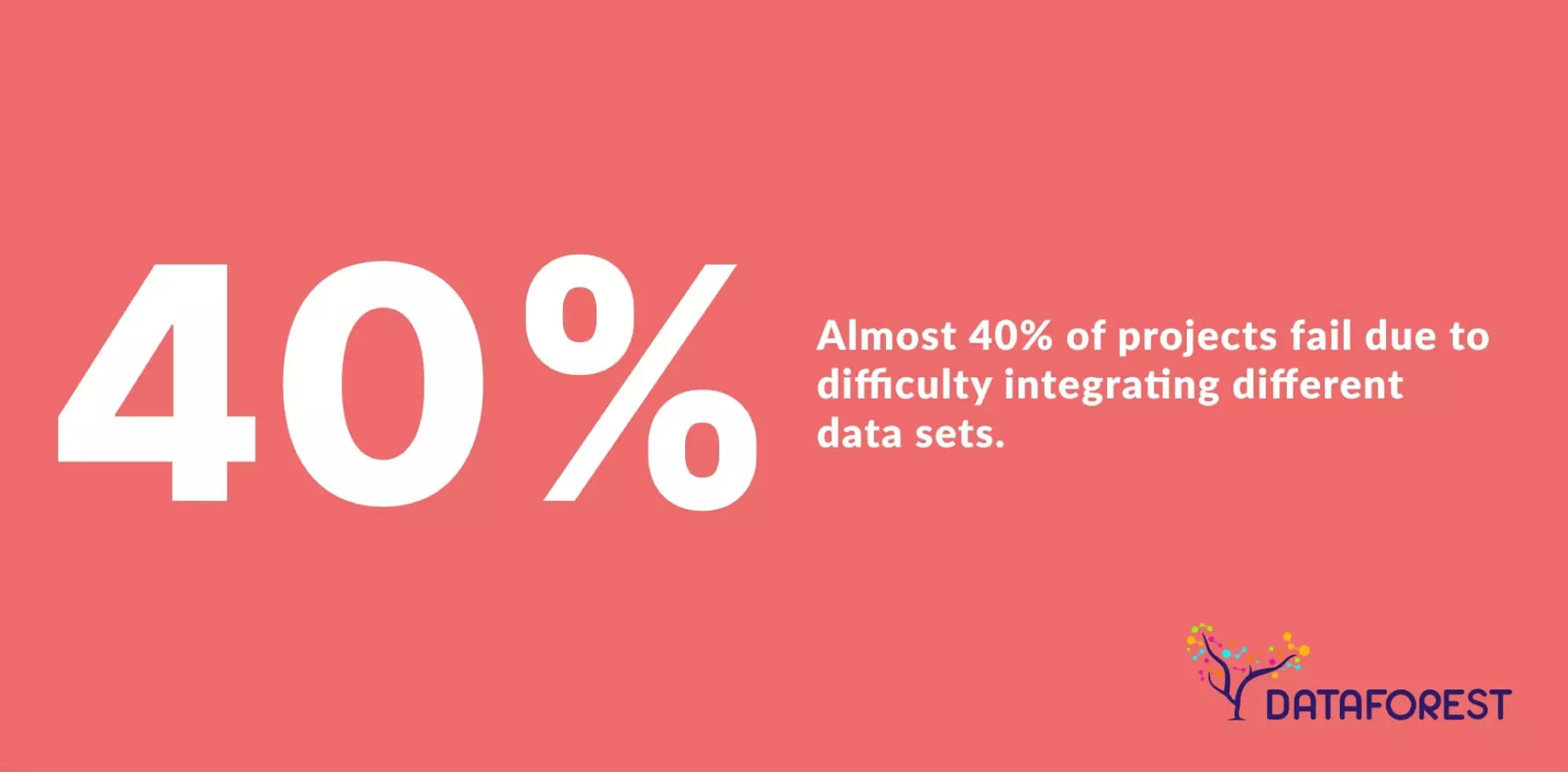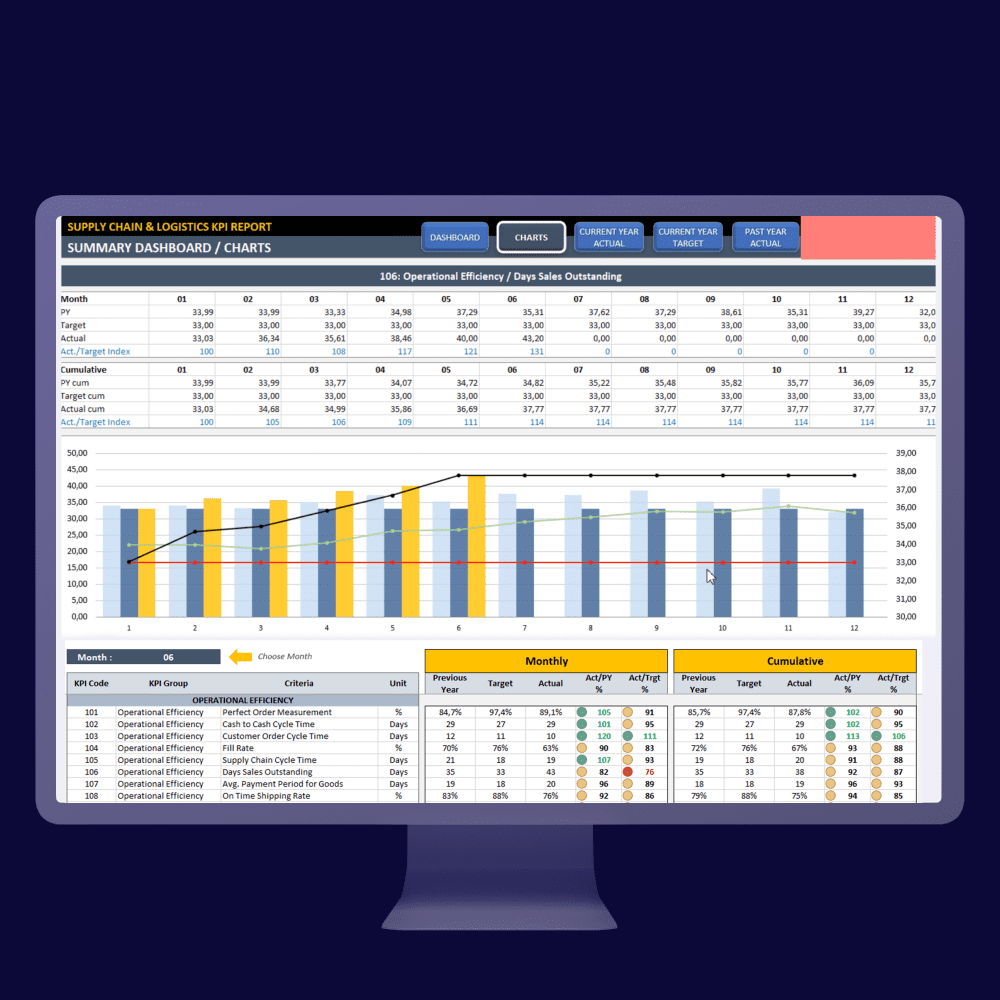The urgency to automate data integration resonates across industries in today's fast-paced digital landscape. While cloud-based solutions gain traction, 24.6% of organizations still lean towards on-premise options, often due to integration challenges. This choice, however, does not diminish the pivotal role of data integration and automation in modern businesses. Surprisingly, companies lose an estimated $9.7 million annually to poor data quality, highlighting a critical need for more robust data integration strategies. Moreover, the daunting statistic that around 40% of projects fail due to integration issues further underscores the importance of effective data synchronization and transformation.

Executives frequently need help utilizing data for decision-making, with 78% expressing difficulties in this area. We can consider your case, just schedule a call.

This struggle is echoed in the AI-driven data integration market, valued at approximately $207.9 billion and expected to grow exponentially. In this context, automating data integration isn't just an option but a strategic imperative for enhancing business processes, data quality, and decision-making capabilities.

The Imperative of Automated Data Integration
Automate data integration is a game-changer for businesses seeking to harness the power of analyzed data effectively. It addresses data collection, consistency, and integration pain points, significantly reducing manual errors and time-consuming repetitive tasks. In a survey, while 77% of respondents aimed for data-driven decision-making, only 46% expressed high trust in their data, indicating a gap that automation of data integration can bridge. Similarly, 70% of those struggling with data trustworthiness cite data quality as their primary concern.
This transition to automated processes transforms how organizations map data flows and manage data ingestion, ensuring higher quality and more consistent outcomes. By automating data integration from diverse sources, companies can foster better collaboration, streamline their processes, and accelerate trends toward digital transformation. DATAFOREST will do the same, you just need to arrange a call.
Integrating automation in data processes isn't just about efficiency but redefining how organizations make decisions. Businesses can expect substantially reduced manual errors and inconsistencies by automating data integration. This shift leads to more accurate and reliable data, essential for informed decision-making. Automated data integration becomes even more significant in an era where timely and precise decisions are crucial for business success.
In this article, DATAFOREST covers how, by embracing automated data integration, businesses are not only optimizing their current operations but are also positioning themselves for future success in an increasingly data-driven world.
The Core of Automation Data Integration
At the forefront of technological advancement in the contemporary business landscape, automated data integration is revolutionizing data management. This practice, pivotal in its ability to merge varied data streams with minimal human intervention, is reshaping the essence of data management. Automate data integration's core value is replacing the cumbersome, prone-to-error manual processes with a streamlined, precise, and quasi-autonomous system.
Why is automated data integration significant? Consider these points:
- Enhanced Productivity: Automate data integration transcends mere efficiency. It accelerates data processes while freeing up human talent for more complex tasks.
- Precision Uplift: The shift towards automate data integration significantly decreases human errors, enhancing the dependability and uniformity of your data.
Reaching Strategic Milestones Through Automate Data Integration
The journey to automate data integration is not just about simplifying operations; it's about achieving critical, impactful milestones:
- Real-Time Data Fusion: Automate data integration equates to providing immediate access to consolidated data, essential for agile, informed business decisions.
- Elasticity and Flexibility: Automate data integration allows for expansion with growing data volumes and adapts to new data sources or changes in existing structures.
- Data Integrity Augmentation: Automate data integration enhances data cleansing and transformation processes, significantly improving data quality.
- Cost-Effective Operations: Automate data integration reduces manual labor and streamlines processes, lowering operational expenses.
Manual vs. Automated Data Integration: A Comparative Analysis
The evolution from traditional methods to automate data integration highlights significant advancements in data integration.
From Conventional to Cutting-Edge Data Integration Practices
- Manual Integration: The traditional approach, often involving exhaustive coding for ETL, could be faster, error-prone, and facing scalability issues.
- Automated Integration: In contrast, automated data integration uses software and technology to refine the ETL process, allowing for real-time data processing, reducing errors, and saving time. It provides remarkable scalability and adaptability to changing data needs.
Limitations and Challenges in Manual Data Integration
- Extended Timelines: Manual integration, a prolonged process, delays data accessibility.
- Increased Error Likelihood: Manual data handling, prone to errors, can lead to inaccuracies in data analysis and decision-making.
- Scalability Concerns: Traditional methods need help with the growing volume and complexity of modern business data and must be faster to adapt to new data formats or sources.
- Resource Demands: Manual data integration requires significant resources, which could be more strategically utilized in other areas.
- Rigidity: Traditional methods often must catch up with emerging technologies or rapidly evolving business environments.
Transitioning from traditional manual methods to automate data integration is crucial in business data management. This shift is more than a methodological change; it represents a strategic transformation, empowering businesses to leverage their data potential fully.
Advantages of Automate Data Integration
Automated data integration offers many benefits to businesses, revolutionizing their approach to data management, analysis, and application. These advantages are pivotal in boosting operational efficiency and enhancing strategic decision-making.
- Improved Efficiency
- Time-Saving: Automated data integration significantly reduces the time required for integrating data. Processes that once took hours or days are now completed much faster.
- Resource Optimization: Manual intervention is significantly reduced with automated data integration, freeing human resources for higher-value tasks.
- Enhanced Accuracy
- Reduction of Human Error: Automated data integration lowers the chance of manual data handling errors, yielding more accurate data.
- Consistent Data Handling: Automate data integration guarantees uniform data processing every time, improving data reliability.
- Increased Scalability
- Handling Large Data Volumes: Automated data integration systems can efficiently manage large data volumes, aiding businesses in scaling their data operations.
- Flexibility with Data Sources: Automate data integration solutions to adapt quickly to new or evolving data sources, ensuring continuous integration without extensive reconfiguration.
Automated data integration processes offer substantial efficiency, accuracy, and scalability benefits. These advantages streamline data management and lay a solid foundation for powerful data analytics and well-informed business decisions. As data becomes increasingly central to business strategies, automating data integration is crucial for maintaining a competitive edge in today's data-centric world.
Vital Elements of Automate Data Integration
Automated data integration involves essential components that collectively streamline the merging of data from diverse sources. Understanding these elements is vital to effectively implementing and managing automated data integration systems.
Data Integration Tools
- Software Solutions: These tools are specifically designed to automate data integration. They include features for pulling data from diverse origins, transforming it, and loading it into a target system.
- Platform Capabilities: Modern data integration tools offer additional functionalities like cloud-based services, real-time processing, and user-friendly interfaces for effortless monitoring and management.
Data Connectors and Adapters
- Connecting Varied Data Sources: Connectors and adapters are essential for linking diverse data sources to the integration tool, enabling access and retrieval from various databases, applications, and repositories.
- Ensuring Compatibility: These components guarantee that data from different sources and formats is integrated accurately and efficiently into a unified system.
Data Pipelines
- Data Flow Management: Data pipelines are organized sets of data processing elements that control the data's journey from source to destination, orchestrating the data integration sequence.
- Automation and Efficiency: Automated data pipelines facilitate a smooth, efficient data movement through different processing stages, ensuring each step is executed correctly and in order.
Data Transformation Engine
- Transforming Data: This engine is tasked with converting data from its original form into a format suitable for analysis and reporting, a critical step for data consistency and compatibility.
- Complex Data Manipulations: The engine manages intricate data manipulations like cleansing, deduplication, normalization, and aggregation, improving the integrated data's quality and utility.
Automated data integration components – including tools, connectors, pipelines, and transformation engines – are the backbone of an effective and efficient data integration strategy. They empower businesses to tackle complex data integration tasks quickly and accurately, ensuring seamless and high-quality data integration.
Implementing Automate Data Integration: Best Practices
Successful implementation of automated data integration extends beyond just employing the right technology. It involves strategic planning and consistent management. Here are some essential practices that can assist businesses in effectively implementing automated data integration systems.
Aligning with Business Strategy in Automate Data Integration
- Business Objective Alignment: Ensure your automated data integration strategy syncs with broader business goals. Understanding how integrating various data sources through automation supports these goals is crucial.
- Data Source Assessment: Evaluate the data sources for integration. Grasping the data's nature, volume, and frequency is pivotal in crafting an efficient and effective automated data integration strategy.
Data Quality and Governance in Automate Data Integration
- Upholding Data Quality: Implement measures to maintain data quality in automate data integration. This encompasses establishing validation rules, processes for deduplication, and regular data quality checks.
- Data Governance Framework: Develop a governance framework for automating data integration and defining policies for data management. This should address data access, security, privacy, and compliance to ensure data integrity and trustworthiness.
Monitoring and Maintenance of Automate Data Integration Systems
- Ongoing Monitoring: Set up continuous monitoring mechanisms for automating data integration processes to identify and rectify issues, ensuring smooth operation swiftly.
- Regular System Reviews: Periodically update and maintain your automated data integration system, including software updates and performance optimization, to accommodate new data sources or changes in existing ones.
- Scalability Provisions: Design your automated data integration system with scalability in mind, preparing for the system to grow and adapt as the business expands.
Implementing automated data integration effectively means aligning with data strategies, ensuring data quality, and maintaining vigilant monitoring and upkeep. By attaching to these best approaches, businesses can refine their data integration workflows, leading to more insightful analyses, enhanced efficiency, and better alignment with business goals. This strategic approach to automate data integration sets businesses on a path to fully harness their data assets and maintain a competitive stance in the marketplace.
Steps for Effective Implementation of Automate Data Integration
Embarking on automated data integration can appear daunting, but breaking it down into manageable steps makes the process more approachable. Here’s a guide to help businesses start with automated data integration:
Step 1: Assess Your Data Environment
- Understanding Data Sources: Identify and comprehend the various data sources for integration, assessing their format, volume, and frequency.
- Current Integration Evaluation: Review existing data integration processes to pinpoint inefficiencies or improvement areas.
Step 2: Set Integration Goals and Objectives
- Define Clear Goals: Establish what you aim to achieve with automated data integration, like reducing manual effort, speeding up data processing, or enhancing data accuracy.
- Outline Specific Objectives: Break down your goals into measurable objectives, such as automating data cleansing or enabling real-time data integration.
Step 3: Select Appropriate Tools and Technologies
- Explore Integration Tools: Investigate various data integration tools, considering factors like compatibility with existing systems and scalability.
- Choose Suitable Tools: Pick tools that align with your objectives and budget. Consider a pilot project to evaluate tool effectiveness before full implementation.
Step 4: Design Your Integration Architecture
- Plan Integration Architecture: Based on objectives and selected tools, design the architecture of your automated data integration system, detailing data flow, transformations, and loading processes.
- Ensure Scalability and Flexibility: Design the architecture to accommodate business growth and adapt to new data sources or format changes.
Step 5: Execute Data Governance and Quality Controls
- Data Governance Policies: Set rules and procedures for data management, including standards for data quality, privacy, and security.
- Data Quality Processes: Include data validation, cleansing, and deduplication in your automated data integration workflow.
Step 6: Develop and Test Your Integration System
- Build Integration Workflows: Construct your integration processes based on the planned architecture, ensuring all integration components are appropriately set up.
- Conduct Rigorous Testing: Test the integration system thoroughly for accuracy, efficiency, and performance in various scenarios.
Step 7: Deploy and Monitor
- System Deployment: After successful testing, roll out the automated data integration system, potentially in phases, to minimize disruption.
- Continual Monitoring and Adjustment: Regularly check the system's performance and accuracy, ready to tweak and optimize as required.
Implementing automated data integration is a systematic process demanding careful planning, the right technological tools, and ongoing management. Following these steps, businesses can automate data integration, leading to more streamlined, accurate, and scalable data management solutions.
Addressing Automate Data Integration Challenges: Solutions and Strategies
Automate data integration comes with its set of challenges. However, by identifying these challenges and implementing strategic solutions, businesses can effectively overcome them and harness the full potential of automate data integration.
The journey to automate data integration is filled with both opportunities and challenges. Organizations can effectively leverage their data assets by proactively addressing these challenges – from data complexity to security concerns. Choosing suitable tools, upholding data quality, and cultivating a culture open to adaptation and continuous learning are essential. As businesses evolve, automated data integration emerges as vital for staying competitive, enabling well-informed decisions, and achieving efficiency in an increasingly data-centric world.
Embarking on the journey of automate data integration can transform how your business handles, analyzes, and leverages data. If you're ready to take this crucial step, explore the resources and expertise we offer at DATAFOREST. Our comprehensive solutions and insights are tailored to meet your organization's unique challenges and needs.
- Discover Our Success Stories: Learn how we've revolutionized data management for businesses like yours. Visit our case studies at DATA FOREST and see the transformative impact of our services.
- Expert Guidance and Services: Need assistance in navigating the complexities of automate data integration? Explore our services at DATAFOREST, where we provide tailored solutions to streamline your data integration processes effectively.
- Connect with Us: Have specific questions or need personalized advice? Don't hesitate to contact us at DATAFOREST. Our team of experts is ready to aid you in harnessing the power of automated data integration.
- Insights and Best Practices: Stay informed about the latest trends, challenges, and strategies in data integration. Our blog at DATAFOREST offers valuable insights and best practices to keep you ahead in the data-driven world.
- Choosing the Right Tools: Looking for the best ETL tools for your business? Check out our recommendations on the top 15 ETL tools for 2024 at DATAFOREST, ensuring you make an informed decision for your data integration needs.
Take the first step towards revolutionizing your data management with automated data integration. Visit DATAFOREST today and unlock the potential of your data. With our expertise and solutions, you're not just integrating data; you're paving the way for informed decisions, operational efficiency, and a sustainable competitive advantage in a rapidly evolving business landscape.
FAQ
How can data quality be maintained in automated data integration processes?
Maintaining data quality when automating data integration involves several vital practices. Implementing stringent validation rules, conducting regular data quality audits, and employing AI and machine learning algorithms for ongoing monitoring and cleansing are effective strategies. These measures ensure that the integrity and accuracy of your data are upheld throughout the automation process.
Is data integration automation suitable for small businesses or organizations with limited resources?
Automate data integration is highly beneficial for small businesses. Cloud-based solutions and scalable tools provide cost-efficient options that fit smaller budgets. These solutions allow smaller organizations to reap the benefits of automated data integration without the need for extensive resources or infrastructure.
Can data integration automation be used in conjunction with cloud-based solutions?
Yes, automated data integration can seamlessly integrate with cloud-based solutions. This combination offers increased scalability, flexibility, and accessibility. It enhances the efficiency and scope of data management processes, making it an ideal choice for businesses seeking agile and robust data integration solutions.
Are there any regulatory or compliance considerations when automating data integration?
When implementing automated data integration, it's essential to be mindful of regulatory and compliance considerations, particularly concerning data privacy and security. Organizations must ensure their automated integration processes comply with appropriate regulations, such as the General Data Protection Regulation (GDPR) and the California Consumer Privacy Act (CCPA). Adherence to these regulations is crucial for maintaining data integrity and protecting user privacy.









.webp)















